LESSON 30: Making Money with Magic
MAKING MONEY WITH MAGIC
Whether you use Magic as a Profession, as a Semi-Profession, or just as a Hobby, you can make it pay you well.
The world is hungry for entertainment and is eager to pay for it. Amusement seekers spend millions every year just to be entertained. You can get in on a share of these millions.
I want you to be a performer who is well paid for his services. I want you to be so clever with your work and so successful that your services will be in demand at a high figure. I do not want you to be known as a CHEAP entertainer. A few underpaid dates may be all right for a few performances while you are breaking in or testing out your work, but if you continue playing them, people will associate you with cheap performing.
Be a Master
Success begets success. Charge good fees and cater to those who can afford to pay them. Assume the part of a Master Magician. Arrange your programs to get miracle effects. See that your publicity paints the right picture of you. You do not need extravagant material—all you need to do is to present everything at its best.
Believe in yourself--in your ability to do things. Feel in your very bones that you are a Master. Feel it strongly yourself--and others will feel it, too. I do not mean by this that you should be conceited or a "know-itall." People hate conceit and bragging. You can make yourself appear great and feel great without saying a word. Merely surround yourself with an atmosphere of genuine and substantial confidence based on a real knowledge. The Master does not have to go around telling people how much he knows. He just makes them feel it. His every word and action, without conceit, are impressive. And so people get the thought that he is a real artist.
Sell Yourself
Make your effects talk for you. Study every possible angle to get the most out of every effect. Strive constantly to perfect everything you do. Watch for features that will make you stand out from the ordinary and make people talk about your ability.
Then you are ready to sell yourself and sell every effect you perform. Remember that two men may be given the same effect --one will build a reputation for himself with it—the other will fail utterly with it. It is YOU that counts—your Salesmanship, your Showmanship.
You know best the tricks—little and big—in your own personality which can help you sell yourself to your audience. Study them and capitalize on them. Bring them out to give you power.
Talk the language that your audience can understand—by that I mean "get under the skin" with them. Show them that you are friendly and understand them and want to please them. You will then gain their confidence, their friendship, and their admiration. And thus you sell yourself.
Be a Successful Showman
The Successful Showman has the great faculty of adaptability in his mental makeup. When in Rome, he is a Roman; when in Greece, he is a Greek. By that I mean that he readily adapts himself to the situation in which he finds himself, always keeping his poise and control.
Elbert Hubbard said, "Love the things that I love, and I will love you; but hate the things I love, and we part company."
I cannot drive that home to you too strongly. People admire the man who is in sympathy with them and understands them. Remember that you are being paid to entertain these people, and it is up to you to study and understand what is entertainment to them. Learn what they like - what they are interested in - and with your entertaining, enter into their very lives.
On your ability to do this will greatly depend whether you get $10 or $100 for a performance. Houdini was paid as high as $1000 for a performance because he was Houdini. He started out as a poor boy, but he studied and mastered SHOWMANSHIP. He adapted himself to his audience — he got their interest and confidence. And in the end everyone rushed to see Houdini play and paid big money for it. You can rise to success, too, if you hit out in the right direction and let nothing swerve you from the right road.
Make Your Magic Fit Your Audience
Right in line with the subject of adapting yourself to your audiences is the important consideration of suiting your Magic to your audiences.
You will find that certain types of effects appeal to certain people. This brings to mind the salesman who carried two lines - hymn books and playing cards. To those who would not buy playing cards, he sold hymn books, and vice versa. You can do the same with Magic. Carry different "lines" to suit different people in your audience.
Men, as a rule, like card tricks and sleight of hand manipulations, tricks with coins, cigarettes, cigars, and other articles with which they are familiar. Women usually like silk handkerchief tricks, flashy silk productions and vanishes, and effects filled with color. They like spiritualistic, psychic, and emotional effects. Children like effects with live animals, candy productions, and effects with articles which they have occasion to know and use. They go wild over the type of trick known to the Magician as a "Sucker" trick, in which they think they have caught the performer and exposed his trick. That is one of the beauties of the Egg Bag Trick, in which the audience thinks the performer placed the egg in his pocket. At a children's party, a rabbit or a guinea pig or some other live animal adds great interest and spice to the occasion.
All this does not mean, however, that men do not like silk productions or women sleight of hand or work with live animals. They do. But they tend to be particularly interested in things which are peculiar to themselves. What you must do is remember to keep everything suited to the occasion and the audience and to give enough variety to please everybody.
MAKE MONEY FOR OTHERS:
A big secret in making money is your ability to make money for others. In direct proportion to the money you make for others is the amount of money you make for yourself. In performing, as you increase the attendance to swell the box office receipts, up goes your value in dollars as a Magician. In the theatrical world certain actors are a box office attraction. They have pulling power, and when they appear the theater is crowded. In your work as a Magician I want you to study the various tricks used to draw crowds by creating the proper impressions and suggestions. Remember that the attraction which pulls in $10, 000, of course, is always worth many times more than the one which draws in only $50—and, naturally, the one that draws the crowds and brings in the money is paid BIG MONEY.
HOW TO GET STARTED:
Start with a firm foundation, and build your structure step by step. Fly-by-night methods are too flimsy. They don't hold up under pressure. Know your work thoroughly and you have a foundation which nothing can destroy. You may make mistakes in the beginning, but let those mistakes spur you on to perfection. Everyone makes mistakes, but wise is the man who profits by them and does not repeat them.
Experience will teach you a great deal. You will learn which tricks stand up for you. You must learn how to present them in the best possible manner. You must learn the little details which it is impossible to teach you — details which have much to do with your success. They arise as you perform and experience will teach you how to turn them to your own good.
All Magicians must go through the process of testing — or, as the profession calls it, "Trying it on the dog," or "Working out in the sticks." With each performance they learn something and gradually perfect their work.
Feel your way along. Know your ground before you venture into big things. Keep your eyes and ears open. Watch and learn. You must become thoroughly grounded first — before you will be the financial success I want you to be.
WHERE TO START:
Do not try to jump into vaudeville or the theater right at the start. Train for it first. Then when the time comes, you will already know the "ropes" and will know how to make good. The chances then of failure and dreadful discouragement are minimized.
You need not go into the theaters to make money with Magic. You can make thousands of dollars without ever entering the theatrical field. Even if vaudeville is your ultimate aim, get your start elsewhere. There are unlimited opportunities to entertain for a good profit. Thousands of societies, clubs, schools, churches, are constantly trying to raise money. Here is your chance to make money by making money for others. There are thousands of other organizations always on the lookout for good entertainment merely to keep up interest in their membership. Give them a good show, and they will pay you good money.
In your Tenth and Twentieth lessons, I gave you a few hints regarding the introduction of small programs into clubs, schools, and churches. I hope that by this time you have presented a few programs with good success.
Make appointments with the various noonday clubs as well as those which meet in the evening. Submit your services to lodges, Y. M. C. A. 's, and other organizations. You are sure to get some engagements.
WHAT TO CHARGE:
After you have done enough test work to see that you are working right, begin by charging $15 for an engagement. This is for a program running from fifteen minutes to half an hour. As you become more proficient in Magic, step up your charges to $20, then $25, $35, $50, $100, and so on.
For out-of-town dates, be sure to add your expenses to your fee.
In the Profession of Magic, you will run across many people who will try to get your services for nothing. Avoid them — except in the beginning for test work or just as a social favor to some friend. Make it known that your Magic Is PROFESSIONAL, and that you charge a substantial fee for your services.
People oftentimes judge you by your fee, so keep it high enough. Strangers are a better field than close acquaintances from whom to get engagements. Cater to those who do not know you too intimately. Acquaintances are apt to discount your ability and the remuneration for your services. Strangers, on the other hand, are willing to pay you well if you are worth it. Remember that high fees help you, and they boost the Magic Profession.
We come now to the subject of a whole evening's show, lasting about an hour and a half.
You have been given some excellent material for an evening's performance, and you are ready to make up a fine program which will be easy to carry and will cost little to produce.
A little farther on in this lesson, I give you two excellent program arrangements. You may use these as they are or work up your own. Then as the Course progresses and you get more and more spectacular material, you can add or subtract from your program which you are going to use now. You can continue this adding of effects and rearranging until you reach your ideal program.
Now, with a full evening's program, you are ready to venture forth to help others make money and to make good money for yourself.
WHAT TO CHARGE FOR FULL EVENING'S SHOW:
Here is a church that could well use the services of a good Magician. Go to the minister, the head of the men's or women's organizations in the church, or the young people's society -- and show them how you can make money for them.
Present your plan in this way: They are to furnish the hall or auditorium and you will furnish the show.
Admission is, of course, to be charged, and you will work on a percentage basis. Because of your initial expense in putting on the show, you will charge the first $25 taken in for yourself. Then you will split fifty-fifty on the rest of the proceeds. Or you may work on a straight percentage of two-thirds for yourself and one-third for the church. Percentages vary according to conditions and may run from 60-40 to 75-25. You, of course, always get the bigger end. On some occasions, a fifty-fifty percentage works out well. Many things must be taken into consideration in determining this percentage -the size of the crowd expected, etc.
Some performers prefer to play for a flat rate of $50, $75, $100 or more. The percentage system, however, is a good one to work on in some cases.
HOW TO GET BOOKINGS:
It is well to make your first bookings personally. In some cases a well written letter will serve the purpose, but, of course, personal contact when possible is better.
Some Magicians prefer to hire an advance man to book for them. You may have a good friend who would like to get dates for you on a percentage. Commissions vary all the way from 5% to 33 1/3%. The advance man's commission is figured from the amount that you net from a performance. If playing clubs, schools, churches, and other such single dates, the percentage is higher than if you play vaudeville where bookings are made in lumps. In the case of single dates, the advance man has expenses and he must work on each date individually. Commissions of 20% and 25% are permissible for this work.
Some Magicians find it profitable to work in this way. They travel in an automobile, and when playing a certain town, they run over to nearby towns to book dates personally. Most of their performances are in the evening, so that they have their afternoons to spend in booking future dates.
One student came up from Indiana to visit a friend in Chicago. He booked three dates on the way up and played them on the way home, and booked four more dates on the way home for the future. That trip proved to be a profitable one for him.
Some performers work independently. They go into a city and rent a hall or auditorium. Then they depend on billing the town and advertising in the papers to bring in the crowd. It is better in the beginning, however, to work under some organization such as a church or Kiwanis Club and get your bookings from them. This organization then works to get a good attendance at your show and spreads publicity for you. They also sell tickets in advance so that a good seat sale is assured ahead regardless of what the weather will be.
As your experience and finances grow, you can get in touch with theatrical managers and play their theaters on a mutual commission or flat rate basis for each engagement. Before you reach this stage, however, you must work up an unusual type of Magic show and must have an extensive line of advertising and publicity.
ADVERTISING AND PUBLICITY:
If you play under the auspices of some school or other organization and depend on public response for your returns, it is necessary to carry your message to the public in such an interesting way that they will want to see you. You must let the town or city know that you are coming -- and you must get the curiosity and interest of the people aroused to the point where they feel they must see you perform.
Many Magicians have a publicity man or manager. This man studies the problem of presenting the Magician to the public as an attraction of unusual interest. He can praise the Magician in no uncertain terms, whereas the Magician would be considered conceited if he used such glowing language himself. Clever publicity managers can absolutely "make" a performer. To begin with, however, you will probably have to handle your own advertising.
Besides the word of mouth advertising which an organization gives you, you must spread publicity in other ways. I give you here suggestions for Window Cards, Newspaper Advertising and Publicity, Folders for Mailing and Handing Out, Business Cards, Business Stationery, and Use of Photographs.
As I explain each, I show you a drawing of that particular piece of advertising in reduced size. At the end of this section on Advertising, I give you these suggestions on a separate sheet so that you may show them to your printer when you have them made up. The business card and the folder are full size. The window card is, of course, reduced in size.
Window Cards -
Window Cards may consist of anything from handmade show cards to elaborate lithographs. I started out by making them in show card style, 14 x 22 inches. I made a funny drawing on each and tried to make them so interesting that people would stop to read them. Sometimes I used ordinary sheets of brown paper with a picture and lettering on them, and they gave me excellent results. In France during the war I put on a performance at the Municipal Theater at Clermont-Ferrand with the assistance of some of the members of the 24th Balloon Company. I made up twelve big posters on show card order and hung them up in prominent places. They were on paper, 28 x 42 inches in size, and were made in colored silhouette style. These posters, together with a small amount of newspaper publicity, did the trick, and the theater was packed. It was a usual thing to see a dozen or more people looking at the posters at various times.
A good show card writer or sign painter in your town can perhaps give you a start by making a good permanent card for you. It is an advantage to have this because you can take it from place to place and display it in prominent store windows wherever you go. Be sure to have a good photograph of yourself on this card — or even three or four photographs --showing yourself doing various tricks.
If you find it too expensive to have a poster handmade, I suggest this very inexpensive substitute. Have your window announcements printed on paper, about 14
x 22 inches and have just a few printed on cardboard. Get a good photograph of yourself doing a feature trick, and be sure that the photographer gets human interest into it. Have a half-tone cut made from the photograph. Your printer can have this done for you. A large cut is, of course, more effective than a small one.
The illustration gives you a layout showing how a Window Card, whether on paper or cardboard, should look.
Folders for Mailing and Handing Out
A great help to you in your work is a good folder which you can mail out to various organizations and which you can leave with those whom you interview. It sometimes brings in many dates.
I give you here a layout for a folder which your printer can follow, see next page. Have him set it up and run off, say 500 copies to begin with. Use white, ivory, or India tinted paper with enamel finish printed with rich brown or blue ink. Get four good photographs of yourself doing feature tricks. Have half-tone cuts made of them by a good engraving house -- the sizes these should be are marked on the layout for the folder. Have the engraver use about 120 screen on them. The folder has four pages and is made up of one sheet printed on both sides and folded in the middle.
The photographs should be only half figures. One may be a close-up. Tell the photographer that you want to get a great deal of interest into them -- something with sales power.
Suggestion for Folder:
This gives the Front and Back Pages. Fold comes along middle line with pages facing outward.
(Inner pages of folder are illustrated on next page.)
Suggestion for Folder:
This gives the two inside pages. Fold comes along middle line with pages facing inward. Folder is, of course, made up of only one sheet-- printed on both sides and folded in the middle to make four pages.
If you have a good press notice or recommendation from some organization which is short and snappy, have it set up in small italics somewhere on the folder. It is a good idea to get recommendations after you play a date. Watch the newspapers and club bulletins and such for articles about you. Put them away in a scrap book for future use in selling yourself. Perhaps you have played some schools in a certain county and can get the Superintendent of Schools sufficiently interested to give you a recommendation -- or perhaps the superintendent of the individual school will give you a good testimonial. Earn your way through as a gentleman every time and make your work so good that people will be glad to recommend you.
To return to the folder—Be sure your name and address are on the folder so that people can get in touch with you. In mailing the folder, always use first class mailing as this is the safest and quickest way to send it. When you interview people personally, leave a copy or two of the folder with them for future reference.
Business Cards
Have your printer also make up for you a good business card. Make your card a little different so that it will attract attention. In time when you are well on your feet, you can afford to have a good handlettered card. Below is just a suggestion for a neat, attractive card. This illustration is much reduced in size.
Business Stationery
Good stationery looks business-like and makes a good impression for you. People judge you in advance of seeing you by these impressions, so that it is important for you to impress them with the fact that you are successful.
For your stationery use a good bond paper with a neatly designed letter-head and envelope-head, perhaps printed in blue ink. Sometimes just a cheap manila stock works up wonderfully for Magic stationery. A red and black effect or a dark blue show up fine and can really make such cheap stationery look distinctive. Try to get your stationery to look more attractive and different from the usual. It is possible to work wonders with little expense.
Newspaper Advertising and Publicity
Arrange with the local newspaper to use a certain amount of advertising space, well placed, and suggest that the editor give you a few words of write-up in the news columns. If you are working under the auspices of a church or school, they perhaps have some influence with the newspapers, and can use it to get you publicity.
You should have a good half-tone cut of yourself for newspaper use. It should be about two inches wide by two and a half inches high. Just tell the engraver that you want a newspaper cut and he will take care of you. Use this cut in your newspaper publicity, as such publicity is doubly effective with your picture.
Here are some suggestions for newspaper notices which you may use as a basis for writing up your own:
NOTED MAGICIAN COMING
Morton High School Announces Novel Attraction for Next Tuesday Night
Hold on to your pocketbooks and be sure there are no rabbits up your sleeves for (Your Name), the famous Magic Man is coming. He will present his ever-popular program under the auspices of the Morton High School at the High School Auditorium next Tuesday, March 8, at 8 p. m.
(Your Name) is an unusually clever performer and presents in his evening's program odd mysteries which he secured from countries all over the world. "The Spirit Mathematician," "Hindu Egg Mystery," "The Haunted Lemon of Ching Foo," and "The Mysterious Japanese Thumb Tie" are only a few of the bewildering experiments which he will perform.
Super-mental feats will occupy the second half of his program. One of his great effects in this line is that in which a member of the audience draws a picture on a piece of paper which (Your Name) does not see at all but which he nevertheless reproduces on a piece of cardboard before the spectators. (Your Name) is famed for his unusual ability in catching mental pictures.
This performance is open to the public. A high degree of interest has been manifested, and a record attendance is anticipated.
HIGH SCHOOL TO HAVE MAGICIAN
(Your Name) Coming With Big Evening of Mysteries
A big evening of mystery and illusion will be that of Tuesday, March 8, at 8 p. m. at the High School Auditorium of Morton.
(Your Name), the famous Magician, is coming with his ever-popular array of odd and baffling effects. His great mysteries come from the Orient -- from Europe — and from America, and he is famed far and wide for his interesting presentations. Among his feature numbers is the great Paper Mystery of Ching Ling Foo, the greatest of Chinese conjurers. Even Magicians have been baffled by this profound mystery.
This is (Your Name)'s first appearance in this community, and a large attendance is expected for the rare treat. Proceeds will be used for the benefit of the Athletic Club.
GREAT MYSTERY MAN COMING
(Your Name), Magician, to Present Evening of Wonders at First Methodist Church Auditorium
The Magic Rabbit is getting ready to make his unexpected appearance at an odd mystery program to be given by (Your Name), the Magician, at the Auditorium of the First Methodist Church, Wednesday night, March 8, at 8 p. m., under the auspices of the Men's Bible Class.
It has always been a mystery how a rabbit could appear and disappear in so many places. He is likely to tumble out of almost anyone's hat and just as likely to vanish in some gentleman's whiskers. (Your Name)'s rabbit is like that. His antics will give you many minutes of fun.
Some of the Oriental mysteries on (Your Name)'s program are particularly interesting. He presents the bewildering "Haunted Lemon of Ching Foo," "The Wandering Egg," "The Spirit Communication," and "The Japanese Thumb Tie," among others.
(Your Name) has been interested in the mysteries of the Orient for some time, and he gets as much delight in performing them as his audience does in seeing them. Special effects in Super-Mentalism are also combined with these mysteries. (Your Name) determines in advance what spectators will think of and catches mental pictures from the minds of spectators. One of his great Super-Mental feats is to have a spectator draw a picture. (Your Name) catches the vibrations and, though he never sees the picture, he reproduces the drawing right before the audience.
The entertainment is for the whole family. For everybody -- young folks to old folks -- Wednesday night will be the most enjoyable evening spent in a long time. The proceeds will be for the benefit of the church.
ARRANGING AN EVENING'S PROGRAM
Building a Magical program is like building a play or any kind of theatrical production. It must be so designed as to gain attention at the very beginning and to hold that attention to the final drop of the curtain. That is done by sustaining interest. You stimulate the emotions of your spectators — then you let them rest — then you stimulate them again — and so on. To accomplish this, you inject variety, suspense, comedy, and climaxes into your work. This keeps your audience from tiring and presents different appeals to interest everyone in your audience.
Arrangement as to type of effect:
The opening effect should be worked quickly and should be very mystifying to get immediate attention. Then should come, what is termed in the show business, a "flash." This may be a clever production of some kind or something else rather showy. It should be worked rather fast, too, and done in pantomime style -- with music, if possible. Do something to stimulate. Then you can go into your various mysteries. In the middle of your program, put a big feature number to renew attention and stimulate your audience again. Then continue with other good effects. And finally, for your finish perform a sensational effect to leave your audience puzzled and talking about you.
Number of Acts:
The number of acts depends, of course, on the occasion and conditions under which you are working. It also depends on your own particular personality and the way in which you can work to the best advantage.
Some performers like to use only one act. Others like to divide the program into two or three acts. If you are doing Super-Mental work, it is well to have two acts - the first one of Magic, and the second of Mental effects. Or the program may be divided into three acts -- the first one consisting of Magic, the second of SuperMentalism, and the third of Magic again.
The show should run from an hour and a quarter to an hour and three-quarters. Regular theatrical performances may run two hours. Divide your acts up to fall within this length of time. The tendency of the beginner is to run his program too long. You can overdo as well as underdo. Keep things moving and remember to STOP at the proper time. Use the vaudeville system of running on schedule time. Avoid long waits between acts -- they tire your audience and destroy your influence over your spectators. BE PROFESSIONAL all the way through. Have everything well organized and running smoothly and your audience will feel that you are well experienced and a MASTER in your art.
Grouping of effects:
In grouping of effects you must follow a logical sequence. A hodge-podge conglomeration is bad. You must make one effect blend into the next just as actions in a play do. Keep your Handkerchief work in one group, Card work in another group, Super-Mental work in another, and so forth. Step up the action and the mystification from one to another.
If you are presenting Oriental Magic in the program, keep it in groups -- Hindu Magic in one, Chinese Magic in another, etc. You may vary this rule a little. If you desire to use a Hindu effect for an opener and another for the finish, or one in the middle of your program, this is permissible, but it must be blended in very smoothly. Always keep in mind the grouping of effects for logical dramatic action.
While you must group effects for harmony, be careful not to group them for monotony. There must be good variety in your program. Avoid giving two tricks of a similar nature, unless one is used apparently to explain the other. If you have to vanish a handkerchief more than once, make the second vanish different from the first. If you do the Kellar Cut and Restored Cord Trick, do not perform the Cut and Restored Ribbon, or the Cut and Restored Something Else. If you do a torn paper mystery, select the method which appeals to you most and accent it. Do not give three or four methods even if they are different -- the effects are somewhat similar. Feature certain effects and do not weaken their power by similarity to some other effect.
You have plenty of tricks to give your program SNAP AND VARIETY.
Framing the Act:
Putting an act together is called "Framing an Act."
Let us look over the many tricks we have learned and with them frame an evening's show. As you progress with the Course, you learn more and more spectacular effects and illusions, but even as far as you have gone, you have a wonderful repertoire with which to put on a "humdinger" of a show.
At the end of this section of the lesson, I suggest two programs for your show. These will help you organize the program which you want to present. You can substitute effects which you want to present. You can substitute effects which you prefer for some of those given, and work up a show to suit your own personality. The BIG IDEA is there for you to follow, and with this as a basis you can work up a mighty interesting program.
Names of Effects for Programs:
Many of the names which I give to tricks in the Course are, of course, merely for description. Some of these names, however, are too obvious to use for the public. Names of tricks used in newspaper publicity, advertising, or printed programs must not reveal the nature of the effect to the public. For instance, you and I would talk to each other about "The Cards Up the Sleeve." On the program, however, we would give it a name like "Invisible Transit." The name, "Japanese Torn and Restored Paper," is too explanatory and should be changed to something more mysterious, like "A Japanese Mystery," or "The Magical Napkin." The name, "Miser's Dream," is all right -- so much better than "Catching Money in the Air."
At times, too, you will want to vary your program, and if a name is general, many effects can be worked under that name without having your audience know. "Invisible Transit," "Japanese Mystery," "The Miser's Dream," for example, might apply to anything from a Coin, Card, or Handkerchief Trick to an elaborate stage production.
As the showman once told his publicity man, "Advertise heavily about our big Hippo." "But," replied the publicity man, "the Hippopotamus that you ordered may not get here in time." "In that case," said the showman, "the Hippo will be the Hippodrome." That illustrates the advantage of a general name.
For your work at this stage you do not need printed programs for distribution to the audience. They would
add to your expense. I explain to you about them here, however, because some organizations get up souvenir programs and I want you to be prepared for such emergencies.
Amount of Paraphernalia:
The two programs which I suggest for you have been organized so that each can be presented with or without an assistant. Each has been worked out also so that it can be packed into a suitcase. Outside of a traveling bag for your rabbit or guinea pig and perhaps a package for the rabbit boxes, all you need is your suitcase.
The packing of your program is very important. Partition off your suitcase into a number of sections, and put the paraphernalia for each trick into its own division. System is important. Keep each trick in its own section in the suitcase. Then you know just where to reach for it when the time comes, and you don't need to spend time fumbling around. Keep as nearly the same arrangement as possible for each performance, and things will work smoothly.
Use of Assistants:
Whether you carry an assistant or not depends greatly on your finances. If the assistant is a stranger, it means extra fare and salary -- and this adds quite an item to the expense account. An assistant is handy to have as he looks after details, helps you arrange your stage, and packs your show for you. Sometimes you can get more money for your act because you carry an assistant.
Often the performer's family helps him out and travels with him. Sometimes it is the wife, the daughter, or son -- or perhaps all three. If traveling is done by automobile, it is as easy to carry all three as one. The money taken in, of course, is for the whole family. And thus with one or more assistants you can build up an elaborate production.
Use of Music:
Music helps your show and smooths over many effects. Perhaps some member of your family plays the piano and can be your accompanist. I have often had music with my shows through the use of a portable phonograph and a few up-to-date records. I have the machine off stage and my assistant operates it. It has worked out very nicely. By using the new-style reproducer, you may be able to work out a nice orchestral effect. It is worth trying.
Some high schools and churches have their own orchestras and are glad to have them give you their services. Music before the show and between the acts is welcomed.
Now, for Your Program Suggestions:
PROGRAM NO. 1
Act I.
1. Opening -- The Vanishing Wand (Lesson 20). A good opening because it is performed easily and
quickly, and the vanish can be made startling.
2. Silk Production from Milady's Hat Box (Lesson 25). This is worked on the same principle as Milady's Hat Box Rabbit Vanish — only silks are used instead of a rabbit. Take a number of silk handkerchiefs or scarfs, the brighter the color the better, and fold each one up separately. Place them together and wrap in another silk. Hold in place by ribbon, thread, or pin. Attach this bundle to lid of hat box as you did the rabbit bag. Have box on a chair. Go through same routine that you do with the rabbit production. When you finally are ready to produce silks, unfold them, spread them out and show to audience, and place each on back of chair as shown.
3. Rabbit Production from Silks (Lesson 30). The silks are picked up from back of chair and a rabbit is
produced from them. This effect is taught to you farther on in this lesson.
4. The "Sucker" Rabbit Box Vanish (Lesson 25). Be sure to build your box large enough to accommodate a fair size rabbit. Rabbits grow rapidly, and if your box is too small, the rabbit will soon outgrow it. You can ascertain the best size through a little experimenting. A guinea pig may be used instead of a rabbit. It will not grow to be very large and is easy to handle.
5. Chinese Paper Mystery with Wintertime in China for ending. (Lesson 4). Use a bright red paper and much larger than the size I suggested in your early lessons. Paint Chinese characters on paper to screen ball and also for good effect. In this effect, make tissue bag on rear of fan as large as you can handle conveniently to get as spectacular an effect as possible. It is easy to dispose of envelope by tearing it to pieces in hand or merely crumpling it up and dropping to floor. The paper which I use for these effects is 5 x 25 inches in size. For stage work effects must be enlarged and elaborated on over the presentation for parlor or any close work.
6. Card and Ribbon Mystery (Lesson 26). Instead of a playing card, use a yellow card with Chinese characters on both sides, made with black ink. Use a bright red ribbon. Work it up in this way as a Chinese trick.
7. The Untying Handkerchief (Lesson 28).
8. Silk of the Flame (Lesson 28).
9. The Wandering Silk from Pocket to Pocket (Lesson 28).
10. King Solomon's Wedding Bands (Lesson 20).
11. The Coin in the Magical Envelopes (Lesson 22).
12. The Miser's Dream with Coins (Lesson 23).
13. The Homing Coins (Lesson 22).
14. The Haunted Lemon (Lesson 7). A variation of the Magic Orange off the tapes, using a lemon
instead of an orange.
15. Producing a Card from a Whole Orange (Lesson 14). You use two spectators in the preceding
effect. Have the same ones help you in this effect, one to select card and one to hold orange.
16. Rising Cards (Lessons 18 and 19). Use your favorite method.
17. Tack It (Lesson 16).
18. The Egg Bag (Lesson 24).
19. The Penetrating Ring (Lesson 11).
20. Japanese Thumb Tie (Lesson 11).
21. Coats, Tapes and Rings (Lesson 7).
NOTE: The number of effects which you perform depends on your speed of working. Keep things moving. If you find this program too long, take out one, two, or even three tricks. You do not have to hurry to keep things in action, but be careful not to let non-essentials delay you in reaching your climax. This program should run a little less than an hour.
Act II.
Super-Mentalism (Lesson 29). Pass out pads and pencils for Mind Reading Act. If you have no assistant, do this before the beginning of Act 1, and explain that it is being done at that time to avoid delay later on. Then if you are working alone, you can manage to develop about ten of the slips between acts. You do not need very many. Even if you answer only six, it demonstrates your mental power. If you have an assistant, however, he can develop more slips for you and get the tablet ready while you perform other experiments.
1. Mystery of the Traveling Numbers (Lesson 8).
2. The Yogi's Prediction (Lesson 29).
3. X-Ray Cards (Lesson 29).
4. Mind Reading Act (Lesson 29).
5. Telepathic Drawing (Lesson 29).
PROGRAM NO. 2
Act I.
1. Opening — The Wand from the Pocketbook (Lesson 30). This is taught to you later in this lesson. Vanishing Wand (Lesson 20).
2. Silk of the Flame with Cigarette Combination (Lesson 28). Light candle. Then take match from box with silk concealed and light cigarette. Produce silk from flame; then vanish lighted cigarette in it with Thumb Tip. Place silk in vest pocket and continue with Silk of the Flame effect.
3. The Egg, the Glass, and the Handkerchief (Lesson 28).
4. The Untying Handkerchief (Lesson 28).
5. The Cut and Restored Ribbon (Lesson 26).
6. Japanese Torn and Restored Napkin (Lesson 4).
7. Thimble Act (Lesson 27).
8. Humpty Dumpty Outdone (Lesson 24).
9. The Egg Bag (Lesson 24).
10. The Card and the Banana (Lesson 14).
11. Cards That Pass in the Night (Lesson 12).
12. Cards Up the Sleeve (Lesson 12).
13. Mystery of the Glass House (Lesson 17).
14. Rising Cards (Lessons 18 and 19). Your favorite method.
15. The Coin in the Magical Envelopes (Lesson 22).
IF YOU HAVE NO ASSISTANT, ASK AUDIENCE TO PARDON YOU FOR A MOMENT AT THIS POINT WHILE YOU PREPARE FOR THE NEXT EXPERIMENT.
Go behind the scenes and quickly prepare for the next two effects which are taught to you later in this lesson. Take rabbit from carrying case and drop him into compartment in Chinese Rabbit Box (described later). Place derby hat with bundle of silks inside the box. Bring box out and place on table.
If you have assistant, just have him bring box out all prepared for the effects.
16. Silk Production from Hat (Lesson 30). Remove hat from box and place on table. Show box empty and set it down behind hat. Pick up hat, getting bundle of silks to rear, and show hat empty. Get silks into hat again, open bundle, and produce silks one at a time, laying them over front side of box.
17. Chinese Rabbit Box Production (Lesson 30). Push silks into box. Release hook and take rabbit out of box by the ears. Pick up box and show it empty. Silks have apparently changed into rabbit. Turn box upside down so that children coming to stage for next effect will not see into it.
18. Unique Box Rabbit Vanish (Lesson 25). Have a boy and two girls come up from audience to assist you. Have them stand at front of stage. You go to rear and place rabbit in box on the stand. Drop rabbit into secret compartment in table top and go through routine. Remove box from table and wiggle it around as though rabbit were jumping inside. Ask boy whether he can hold rabbit without dropping him. As you give box to boy, wiggle it to give comedy touch. Then say, "I'll have to hypnotize him to keep him quiet." Wave your hand over box, and box then remains quiet. "There, he has gone to sleep." Put your head to box and say, "I hear him snoring. Do not drop him now. Hold tight onto the box. Here, girls." Go over to table and pick up a toy pistol and a little toy hatchet and give one to each girl.
Continue with this Patter: "You take this pistol, and if he tries to jump out of the box, shoot him. And you, Mary, take this hatchet and bean him on the ears if he gets too frisky. And, Bill, you just wait a minute and we'll fence him in."
Remove the table top quickly and in a careless manner and place it against back of chair or back wall of stage, or if you have an assistant, give it to him. Pick up the table, show it casually, come over to Bill and place it over his head.
"There, Bill, we've got the rabbit fenced in."
Place girl with pistol on one side and girl with hatchet on other. Reach over and place ear near box, and say, "I wonder whether he is asleep yet? He seems unusually quiet. Maybe he is dead. Well, we cannot take any chances. Sally, you have your pistol ready to shoot and, Mary, be ready to hit him on the ears. I'll open the box, and if he jumps out, we'll get him."
Take box from boy, and holding lid toward audience, slowly open it a little. Then quickly close it. "Are you ready, girls?"
Open box. Of course, it is empty. Reach inside to look for rabbit supposedly—then have Bill look inside-and show to audience.
"HE'S GONE! I guess he must have died and gone to rabbit heaven. Well, good-bye, Bill." Shake hands with the boy.
"And good-bye, girls."
Take pistols and hatchet from girls and shake hands with them.
"You did your part well, and if Bunny had jumped out of the box, I know you would have got him. But, anyway, if that rabbit ever comes back as a spook, we'll sneak up behind him and catch him when he isn't looking."
Act II.
1. King Solomon's Wedding Bands (Lesson 20).
2. The Bartender's Dream (Lesson 30).
3. Coats, Tapes, and Rings (Lesson 7).
4. Japanese Thumb Tie (Lesson 11).
5. The Spirit Mathematician (Lesson 8).
6. Telepathic Drawing (Lesson 29).
7. The Chess Knight's Tour (Lesson 29).
STAGING YOUR PROGRAM
Of great importance in staging a Magical performance is having every piece of apparatus in its place and in the same place, as nearly as possible, for each performance. This system eliminates groping around for paraphernalia. You know just where to locate each article almost without thinking. Each effect should be grouped by itself if possible. The partitioning of your suitcase helps this. It gives you a definite place from which to take paraphernalia for an effect so that you can work with snap—and it gives you a definite place for clearing away your effect without delay when you have finished.
You have enough to think about in presenting a performance without having your mind loaded with unnecessary details, such as finding your apparatus. You must keep all your attention concentrated on SHOWMANSHIP and not scatter it around on many unimportant details.
Have your show in such shape that you can set it up and pack it away very quickly. After you have had some experience in the routine of staging a program, things will begin to work more automatically for you.
ARRANGEMENT OF STAGE SETTING
Dress the stage the best you can with the material you have. Study color effects a little and style of arrangement. Keep the stage neat-looking. Keep material not in use at the moment as far in the background as possible. Things in use should be made to stand out. Because of spectators coming up to assist you, be sure that apparatus on stage is well protected against close observation. A handkerchief or cloth will help to conceal things. Keeping things far back also helps to conceal them. Sometimes one or two effects can be kept off stage until ready for use. Allow plenty of space at front of stage for spectators assisting you.
When two acts are being given, the material for the first act should be cleared away and new material set
in place for the second act. This gives a new note of interest for the second act.

The illustration shows arrangement of a stage which I have used when only card tables and chairs were available.
This last section of your lesson is taken up with teaching you some new effects which were listed on your program suggestions:
1. WAND FROM POCKETBOOK
A novel way of producing a wand, which makes a good opening number. This is adapted to either the regular wand or the special vanishing wand described in Lesson 20.
EFFECT:
Performer shows a small pocketbook, to be empty. He then suddenly draws out his wand from the inside of the pocketbook. The wand is struck on the table to show that it is solid.
PARAPHERNALIA:
1 -- A small pocketbook, such as is used to carry small change, with a clasp at top. About two or three inches is a good size.
2 -- A duplicate pocketbook, in case you want to pass it out for examination. 3 -- Your regular wand or the special vanishing wand.
SECRET:
To Prepare:
Cut an inch or even two-inch slit in the bottom of pocket-book, through which the wand can be easily drawn. Make edges of slit smooth. You can easily determine the best size opening in bottom of purse for you to insert tip of wand into easily, Figure 1.
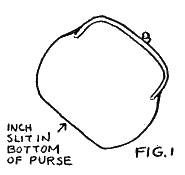
Place prepared pocketbook in right coat pocket or other pocket easily reached by right hand.
If you want to show pocketbook after production of wand, place unprepared duplicate in left trouser's pocket.
Insert wand up left sleeve, letting one end rest at base of second finger, Figure 2.
Wand may be dropped down farther to facilitate working at times. Forearm can be raised and lowered with back of hand to audience, and wand will not be discovered. Avoid any stiff movements.
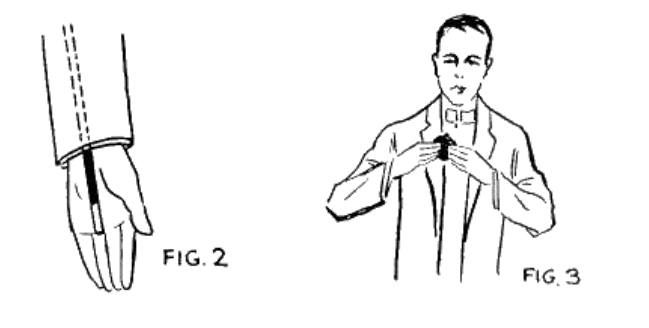
To Perform:
Remove prepared pocketbook and show freely. Conceal slit at bottom with fingers, Figure 3.
Place pocketbook in left hand with bottom of purse against end of wand. Squeeze sides of purse a little. This will open slit and allow wand to be inserted. Open pocketbook with right hand and reach in with thumb and first two fingers. Grasp end of wand and pull it through pocketbook, Figure 4.
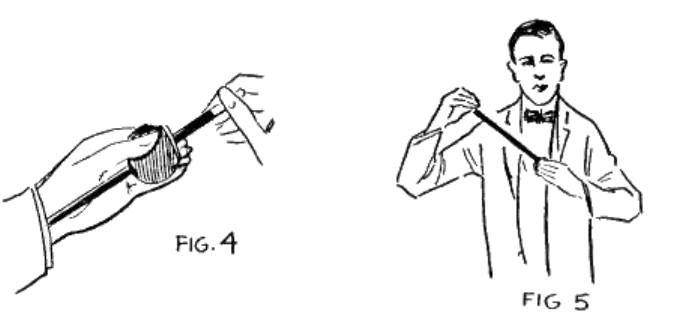
The effect is that you actually pull the whole length of the wand from the inside of the purse. The illusion to the audience is perfect, Figure 5.
Have a table at your left. Turn to left so that right side is toward audience. Strike wand on table to show that it is solid. As you do this, reach into left trouser's pocket with left hand as it is screened. Leave prepared purse there and remove unprepared purse. Turn to face audience again. Pass out purse for examination.
In performing on the stage and in using this production for an opening number, you do not take the time to give out the pocketbook for examination, but in club or parlor work, it is a very satisfactory conclusion to the effect.
2. CIGAR FROM POCKETBOOK
This is one of Ed Reno's favorite effects, especially as an impromptu stunt off stage and at close quarters.
EFFECT:
Performer reaches into pocket and brings out a small pocketbook. He opens it, reaches in, and brings out a large cigar, many times larger than the purse. He then passes the purse out for examination.
PARAPHERNALIA:
1 -- A small purse, about an inch and a quarter wide.
2 -- A duplicate purse.
3 -- A good-sized cigar.
SECRET:
To Prepare:
Slit bottom of purse as you did in preceding effect to allow enough room for cigar to be drawn through. Insert cigar in slit. Put both purses in left trouser's pocket. Have cigar extending upward in pocket, Figure 6.

To Perform:
Reach into pocket with left hand and grasp prepared purse. Cigar automatically comes into inside of hand. Keep back of hand to audience to conceal cigar, Figure 7.
With right hand open purse, reach in, and bring out cigar. Close purse and hand cigar to a spectator. As you do this, turn right side to audience. You can then exchange purses by placing hand in left trouser's pocket. Pass out unprepared purse for examination.
Reno varies this occasionally by producing a large jack-knife with open blade, or if seated at the table, he produces a table knife from the little purse.
3. WAND FROM CARD CASE
This effect is a good opening for tricks with cards.
EFFECT:
Performer picks up deck of cards in case, opens case, removes cards, and places them on table. Then he reaches into card case again and brings out his wand.
PARAPHERNALIA:
1 -- A deck of cards in the cardboard case.
2 -- A wand.
SECRET:
To Prepare:
Remove cards from case and in bottom of case, cut a hole about an inch long and the width of the bottom, Figure 8.
Have wand up left sleeve with end resting against middle finger of left hand. Keep back of hand to audience.
Have deck of cards in case on table at your right or in right coat pocket.
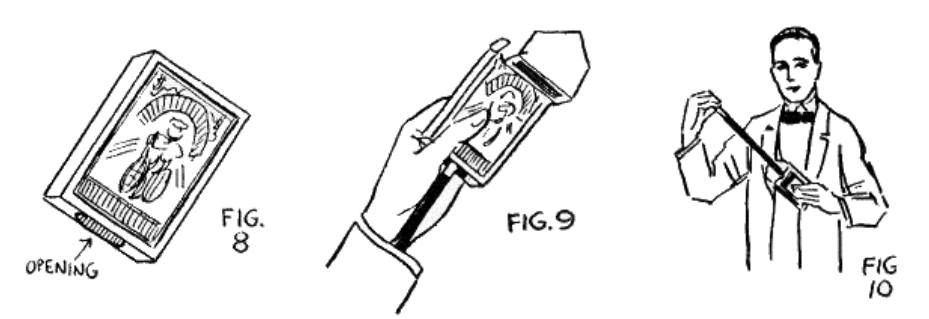
To Perform:
Pick up deck of cards and show freely but be careful to conceal hole in bottom of case. Place case in left hand and open flap with right, removing the cards. Place cards on table at right side, and as you do so, get end of wand inserted in hole in case, Figure 9.
Reach into case with right hand and draw out the wand, Figure 10.
Toss case on table in an apparently careless manner, but be careful to get it in such position as not to expose hole in bottom.
4. SILK PRODUCTION FROM HAT
This is for use on the programs which I suggested for you.
EFFECT:
Performer shows a hat empty and then reaches into it to produce a number of large silk handkerchiefs.
PARAPHERNALIA:
1 -- A number of large silk handkerchiefs, preferably brightly colored.
2 -- A hat. preferably a derby, though a soft one will do. You may borrow a hat from the audience or use your own.
SECRET:
To Prepare:
Fold each silk separately so that it can easily be spread out. Place silks on top of each other and wrap securely in a black or dark blue silk handkerchief. Wrap as tightly as possible and pin end of handkerchief to hold. The bundle should be oblong and as small as possible. The size of the bundle depends on your ability to hide it. About six handkerchiefs wrapped in the seventh dark one make a fair production.
To Perform:
If you use a borrowed hat, have bundle of silks tucked up under left arm pit and hold it in place with pressure of arm against body.
Borrow the hat and hold it in left hand. On way back to stage when your back is toward audience, quickly reach up with right hand and bring bundle of silks down to front of body. Bring left hand with hat up and drop silks into hat. While doing this start turning to right and finally face audience. To audience it appears that you merely took hat back to stage and then turned around to face them.
If you use your own hat, the bundle of silks may be inside of the hat ready for use.
Grasp front brim of hat with right hand and bring it upward. Have right side to audience. Place left hand in hat to hold silks and invert hat onto left hand, Figure 11.
Grasp edge of hat again with right hand and lift hat clear of bundle in left hand. Left fingers conceal bundle, Figure 12.

Keep turning hat until bundle is on top of brim at back of hat. It must be held and concealed all the time with left hand.
When bundle is in this position, hat may be shown empty, Figure 13.
The movements for removing bundle from inside of hat so that it may be shown empty are illustrated in Figures 14 to 18. Study them carefully.
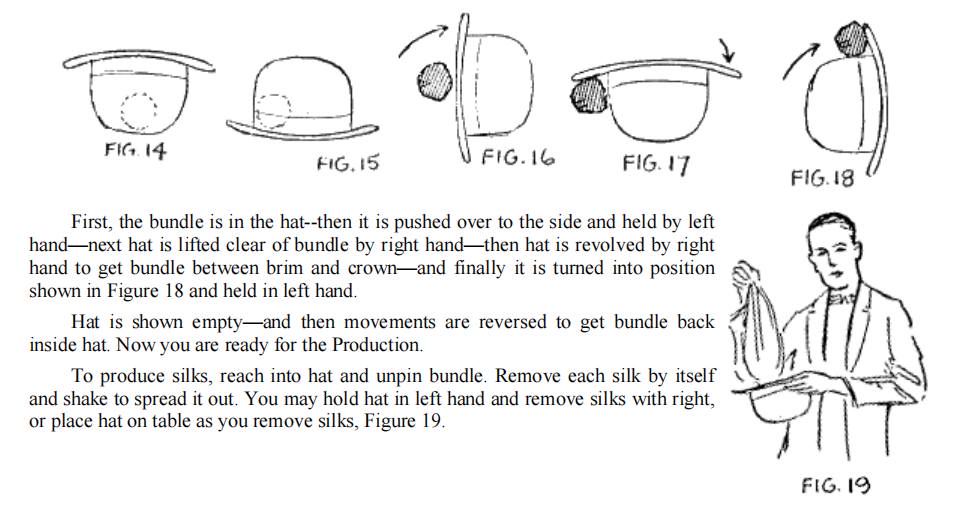
First, the bundle is in the hat--then it is pushed over to the side and held by left hand—next hat is lifted clear of bundle by right hand—then hat is revolved by right hand to get bundle between brim and crown—and finally it is turned into position shown in Figure 18 and held in left hand.
Hat is shown empty—and then movements are reversed to get bundle back inside hat. Now you are ready for the Production.
To produce silks, reach into hat and unpin bundle. Remove each silk by itself and shake to spread it out. You may hold hat in left hand and remove silks with right, or place hat on table as you remove silks, Figure 19.
5. CHINESE PRODUCTION BOX
A very serviceable piece of apparatus for producing, vanishing, or transforming rather large articles and live animals, such as rabbits, etc. It is easy to construct.
EFFECT:
A Chinese box with no lid is shown empty. Then it is placed on a table or chair. Performer shows an empty hat, then suddenly produces a number of silks from it. Magician then drops silks into box and changes them into a live, squirming rabbit which he pulls out of the box by the ears. Box is shown empty.
PARAPHERNALIA:
1 -- Specially constructed Chinese Box.
2 -- Several silk handkerchiefs.
3 -- A rabbit.
SECRET:
To Prepare:
The box which I use is 12 inches square—the size may be varied according to size of production. For a long time my box was made of corrugated cardboard with the edges reinforced with gummed paper tape. I painted the tape dark green. On the box itself I painted Chinese figures in red and lined the box with dark figured cretonne.
The mechanical arrangement in the box is a flap of corrugated board attached to the bottom of the box with gummed paper tape which acts as a hinge. The box may be made of three-ply wood and the flap hinged on. Figure 20 shows flap arrangement. It is shorter than the height of the sides of the box and is hinged across the middle of the bottom of the box.
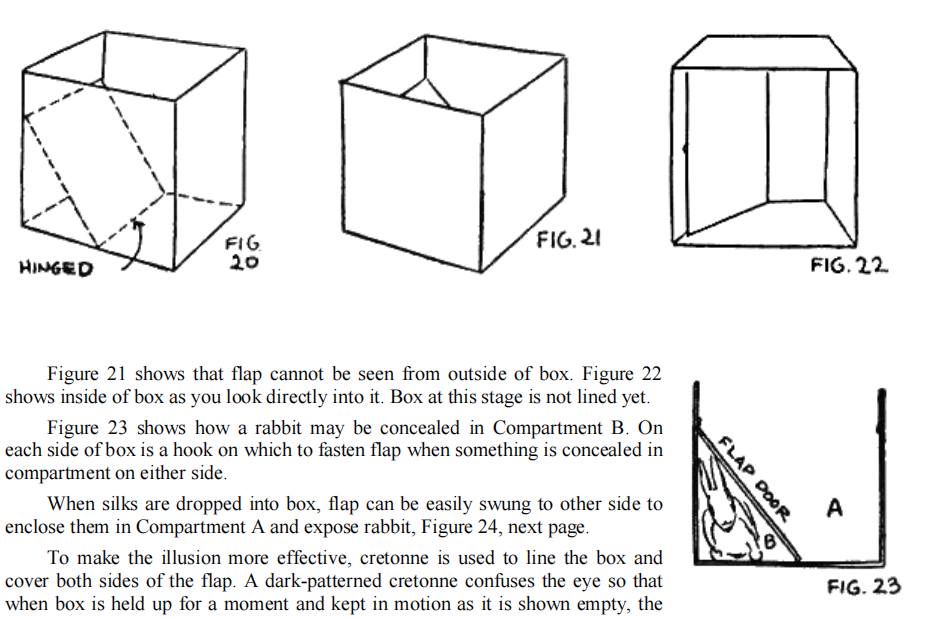
Figure 21 shows that flap cannot be seen from outside of box. Figure 22 shows inside of box as you look directly into it. Box at this stage is not lined yet.
Figure 23 shows how a rabbit may be concealed in Compartment B. On each side of box is a hook on which to fasten flap when something is concealed in compartment on either side.
When silks are dropped into box, flap can be easily swung to other side to enclose them in Compartment A and expose rabbit, Figure 24, next page.
To make the illusion more effective, cretonne is used to line the box and cover both sides of the flap. A dark-patterned cretonne confuses the eye so that when box is held up for a moment and kept in motion as it is shown empty, the box appears ordinary and empty. The illusionist has learned that proper cretonne is a great aid in some cases. To line the box, merely coat the sides and both sides of flap with glue and paste cretonne in, Figure 25.
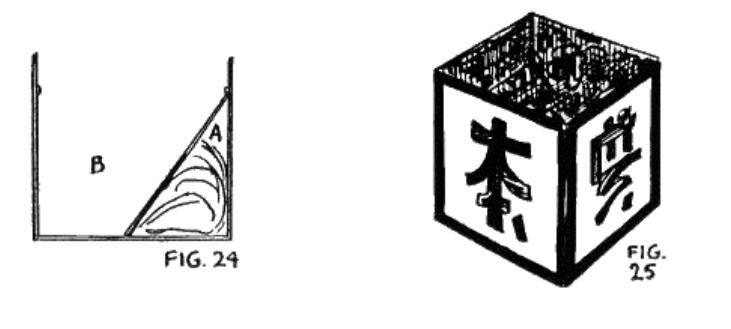
To Perform:
Pick up box and keeping it in motion, show it to be empty. Replace on table or chair. You have rabbit concealed in Compartment B.
Produce silks from hat and lay them over front edge of box. Put hat aside. Pick up silks with one hand and box with other. Show box empty again quickly. Drop silks into box. Unhook flap and swing to other side to conceal silks. Hook flap quickly into place.
Pull rabbit out by the ears and hurriedly show box empty again.
A RABBIT TRAVELING BAG
In transporting small animals, such as the rabbit or guinea pig, it is well to have a traveling case for them. It is a great convenience in handling them.

Figure 26 shows a good bag. It is like a traveling bag but has an opening at one end with a screen over it for air. Animal stores usually carry various kinds of traveling bags for animals. You can have one made, however, in the repair department of some trunk shop.
6. DE LUXE SILK PRODUCTION FROM HAT
This is another silk production from a hat in which a large number of silks are used and then changed into a rabbit.
EFFECT:
A derby hat is shown empty, but in a moment, the Magician reaches into the hat and brings out silk after silk.
PARAPHERNALIA:
1 -- A number of large silk handkerchiefs and perhaps a thin silk scarf or two. Use brilliant colors.
2 -- A derby hat. Other kinds of hats may be used, but a derby lends itself better to the manipulation.
SECRET:
To Prepare:
This is worked with the Chinese Box. Prepare silks in a bundle as you did for the Silk Production from Hat described above. Take a piece of black thread and wrap it once around the bundle and tie. Leave about three inches at free end of thread. Tie this around a pin and insert pin in edge of brim of hat, Figure 27. If threaded edge of hat is held at top, bundle falls down into inside crown of hat, Figure 28.
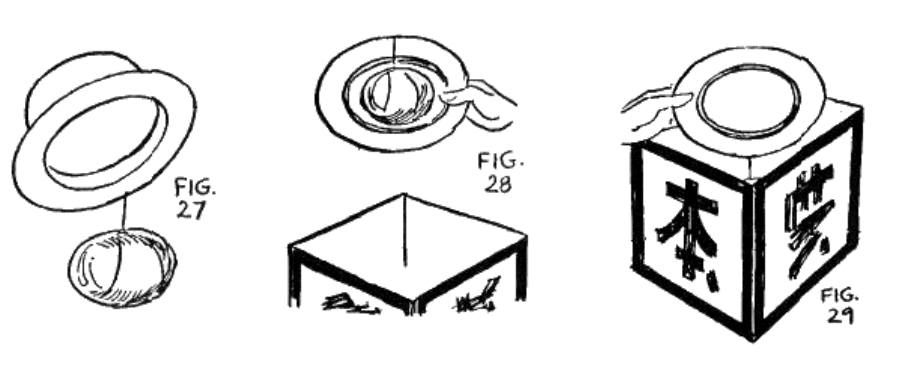
To Perform:
Show back of hat to audience with bundle concealed inside of crown as in Figure 28.
Bring hat down to box. Turn it as you do so to bring threaded brim below. Bundle will drop out of hat and will hang by thread from brim of hat. Inside of hat can then be shown to audience as empty. Hold hat low enough to conceal bundle inside of box, Figure 29.
Now turn hat forward and downward and let it rest across corner of box. Bundle is still inside of box suspended from rear brim of hat. Pull back sleeves a little, then pick up hat again from edge of brim marked A, see Figure 30.
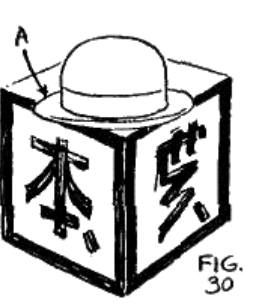
Raise rear edge of hat but keep front edge on box until bundle has been brought up inside of hat and is concealed. Tip hat forward until opening is upward. Reach in, unfasten silks, and produce them one at a time, laying them over a chair after you show them.
7. PRODUCTION OF RABBIT FROM SILKS
This is a good method for producing a good-sized rabbit.
EFFECT:
After producing a good quantity of silk from a hat or box, Magician picks up the mass of silk and calls attention to the fact that it is so bulky that it could never be put back into the hat again. Suddenly he discovers a rabbit among the silks and pulls him out, wiggling and squirming, from the mass.
PARAPHERNALIA:
1 -- A rabbit.
2 -- A chair, preferably of dining-room type. In emergency a folding chair can be used. 3 -- A special rabbit bag.
SECRET:
To Prepare:
The Chair -- Cover top of chair with a decorative drape to conceal it. It is easy to make a drape and put two small strings at two corners for trying it on -- or it may be tacked on with a few thumb tacks.
In the center of the back of the chair, drive a four-penny nail. Have it slant upward and far enough out from chair so that you can hang a bundle on it securely. Some performers prefer using a nail without a head or with a very small head to speed up working, Figure 31.
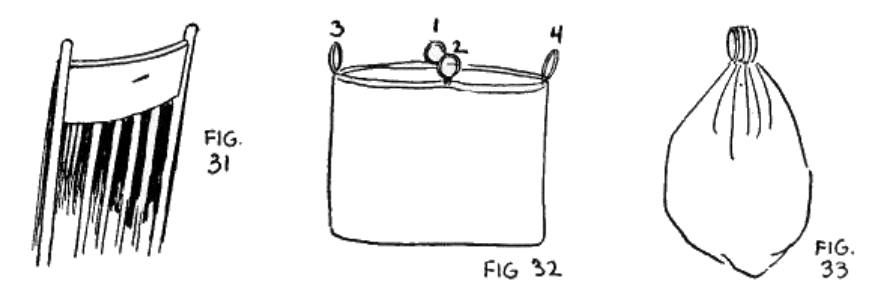
The Rabbit Bag -- I shall explain here the Four-Ring Rabbit Bag, and farther on I shall tell you about other types of Rabbit Bags.
The Four-Ring Bag is very simple. Just make a bag of dark-colored cloth, large enough to hold the rabbit. Hem the top well so that four rings can be sewn securely into place -- one at each end and one at each side. When the rabbit is put into the bag, feet down and head up so that he rests easily, pull the rings together in this order: first, 1 and 2, then 3 and 4. All four rings are thus ready to slide over nail on back of chair. Have rings about an inch in diameter so that finger can be inserted in sliding off nail, Figures 32 and 33.
For comfort of rabbit, sometimes a pasteboard bottom is placed in bag. Frank Caesar, a prominent Magician, sometimes uses a tin or china plate in bottom of bag for rabbit to sit on — then before or after producing the rabbit, he produces a plate for him to sit on, Figure 34.
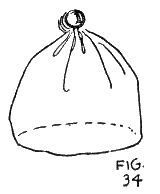
Figure 35 (see next page) shows Rabbit Bag arranged on back of chair. This is turned away from audience so that they cannot see it.
To Perform:
After you have produced silks, spread them over top of chair. They will fall behind and over top part of Rabbit Bag, Figure 36.
As you remove silks from chair, insert second finger of right hand into rings of Rabbit Bag and slide them off nail. Raise Bag up under cover of silks and come forward with it, Figure 37.

Remark about the difficulty of getting so many silks back into the hat again. Look at silks a moment.
Grasp Ring No. 1 through the silks with left hand and release other rings from right hand. The bag falls open. Reach in with right hand, grasp rabbit securely by the ears, and bring him out, Figure 38.
Show rabbit to audience. The silks in left hand conceal the rabbit bag. Drop silks and place rabbit over left arm. Pet him a bit so that children in audience can get a good look at him, Figure 39.
CHINESE BOX VANISH FOR RABBIT
Have the Chinese Box loaded with candy kisses (candy wrapped in paper) in place of silk load. Have a good quantity of these kisses.
Pick up box and show it empty, then replace on table. Show bunny, holding him by the ears, and then drop him into box. Swing flap over and hook into place to conceal bunny.
Pick up box and pour the candy kisses out into a bowl. Then show box empty. Distribute candy to children, Figure 40.
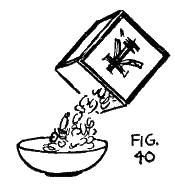
OTHER RABBIT BAGS:
The Loop Rabbit Bag: Figures 41 and 42 show the bag. The top is hemmed well. Round holes are then cut in the top an equal distance apart. These holes are buttonhole stitched to keep from raveling. At one end a loop of tape or shoe string is sewed on securely. Rabbit is placed in bag. Loop A is then threaded through the holes all around the top of the bag back to the starting point. This serves as a drawstring.
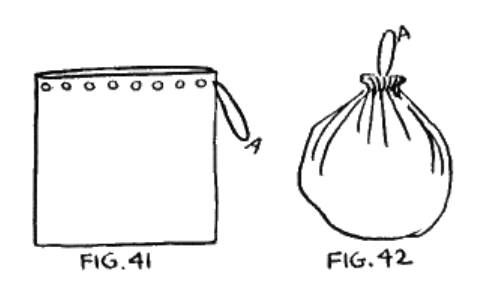
When top of bag is drawn together, bag can be hung on nail at back of chair by the loop. When bag is removed from nail and loop released from fingers, the bag opens easily. The loop need not be very long. You can best determine the length for yourself by finding the most convenient length for you.
Another bag similar to this one has, instead of holes cut into it, small rings sewed along the top about an inch and a half apart. The loop is passed through these rings.
The Handkerchief Rabbit Bag: Figure 43 shows the construction of this bag. It is made from a black or
dark-colored handkerchief. A ring is sewed at each corner and a larger one a few inches from one corner.
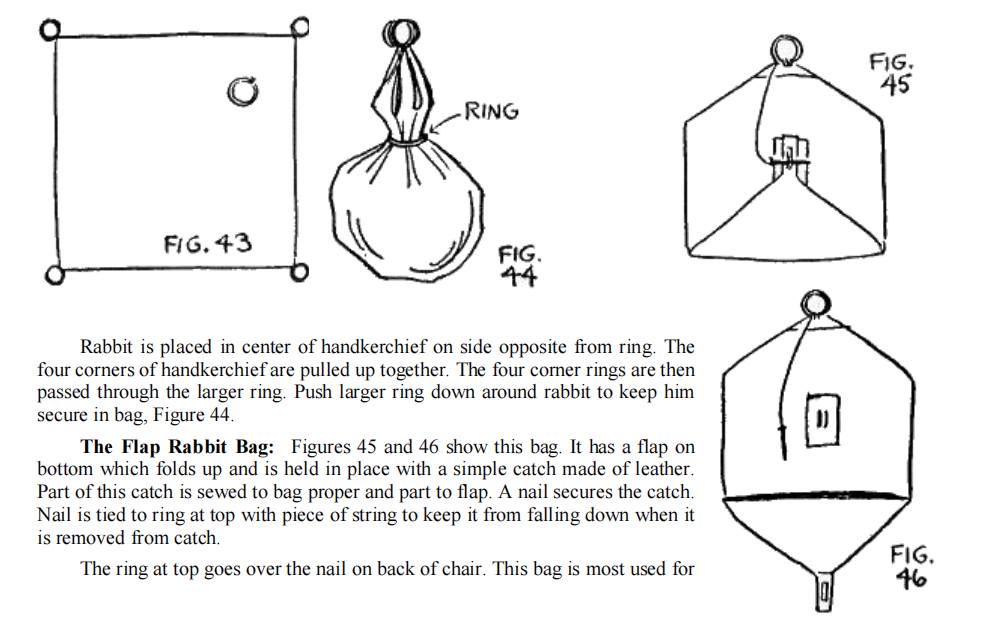
Rabbit is placed in center of handkerchief on side opposite from ring. The four corners of handkerchief are pulled up together. The four corner rings are then passed through the larger ring. Push larger ring down around rabbit to keep him secure in bag, Figure 44.
The Flap Rabbit Bag: Figures 45 and 46 show this bag. It has a flap on bottom which folds up and is held in place with a simple catch made of leather. Part of this catch is sewed to bag proper and part to flap. A nail secures the catch. Nail is tied to ring at top with piece of string to keep it from falling down when it is removed from catch.
The ring at top goes over the nail on back of chair. This bag is most used for
a quick production of pigeons or a duck. When catch is released, flap falls down and out come the animals.
It is also good for production of candy kisses when there are children in the audience.
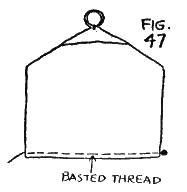
The Basted Bottom Bag: Figure 47 illustrates this bag, which is also most often used for quick production of doves rather than rabbits. Make a cloth bag like the illustration with a ring at top. Put animals into bag with open bottom. Then attach a small button to a thread and baste bottom of bag, leaving a few inches of thread at free end. When ready for production, merely grasp button and quickly pull out basting thread. This opens bottom of bag and releases animals.
TARBELL SYSTEM, INCORPORATED, Chicago.
LESSON 31
Another very interesting lesson on SUPERMENTALISM AND MIND READING. More effects and more methods in this fascinating division of Magic. When you have studied this lesson, you will be very thoroughly informed on these subjects and can give Mind Reading Acts which will make a reputation for you.
Bạn đang đọc truyện trên: truyentop.pro